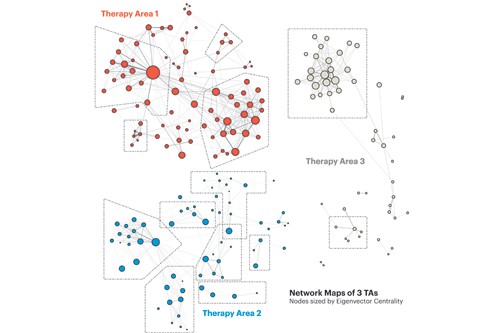
In last month’s article, we established the value of getting to know individual key opinion leaders (KOLs) and their needs, beliefs and aspirations. This month, we look at how mapping the KOL landscape can advance this knowledge and your understanding of the disease area as a whole.
The goal of mapping should be much more than a ranked list of names. The breadth of parameters investigated – publications; positions of influence, including committee and advisory roles; peer esteem as gauged in interviews – allows a good KOL map to shed light on the structure and complexities of an entire therapeutic field.
Below we’ll examine two key components of the mapping process, to establish what information each can provide, and how it can help you.
Indicators of influence
Mapping breaks down influence by HCP type: do the leading KOLs belong to one discipline or several? In HPV, for example, influencers include virologists, immunologists, pathologists and epidemiologists. Is there a role for primary care, or for nurses? Do prominent figures within patient groups or professional bodies feature? Mapping also pinpoints the congresses, societies and journals in which KOLs play a role and to which they pay most attention.
Whether this information provides you with a primer for an unfamiliar disease area, substantiates your existing knowledge of the field or challenges your previous assumptions, it can be a powerful aid to strategic planning. It may identify customer types you thought unimportant, or channels of communication you hadn’t considered. It can help in segmenting KOLs by career phase: rising star, peak career, or eminent but less active. It can also help differentiate by skillset: useful when you’re looking for speakers or investigators; candidates for commercial or scientific ad boards; or experts in a specific class of drugs or aspect of management.
Network maps
Network maps are now a common feature of opinion leader identification projects, but rarely the powerful tool they ought to be in the client’s hands. We agencies often fail to explain the wealth of information to be gained from them, and either over-simplify our findings or deliver a mass of data that overwhelms.
Network maps should be easy to understand and geared towards insight. Using Eigenvalue centrality, a measure which also powers Google’s PageRank system, we plot how individuals fit within the overall network. Individuals with the most connections are not always the most influential: what really matters is where those connections lead.
Network insights can shape an engagement programme. If you know which KOLs are closely connected and therefore likely to agree, you can select advisory board participants with a diverse range of views on management or science. And when an activity calls for it, you can ensure you’re working with a cohesive group.
When a major charity asked us to map KOLs in its disease area, we identified one individual as being central, and only five others who could be described as highly connected. Individuals with high Eigenvalue scores are likely to act as information hubs for their peers; identifying them can help you design a message campaign built to succeed.
Sometimes, network maps are more valuable for the questions they pose than for those they answer. The figure on the right shows maps for three disease areas. A glance reveals they are vastly different: in numbers of closely-knit groups; in interactivity between groups; and in the number of connecting individuals, or ‘mavens’, in each. What do these network features mean and how will they help you and your product? That depends … but it would be enlightening and fruitful to find out.
Whether conducting your own KOL mapping or working with an agency, start by asking yourself: what would I do with the information gleaned? What decisions do I need to make and how will this help? Only then decide on parameters for your literature search, on relevant indicators of influence, and on fine-tuned questions for peer interviews. The resulting mapping will provide a wealth of insights that will make your KOL engagement programme specific to your product, targeted to your needs and highly effective.
For more information on key opinion leader mapping contact Neil Kendle via email neil@kendlehealthcare.com or visit www.kendlehealthcare.com





